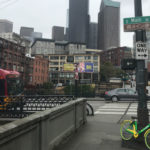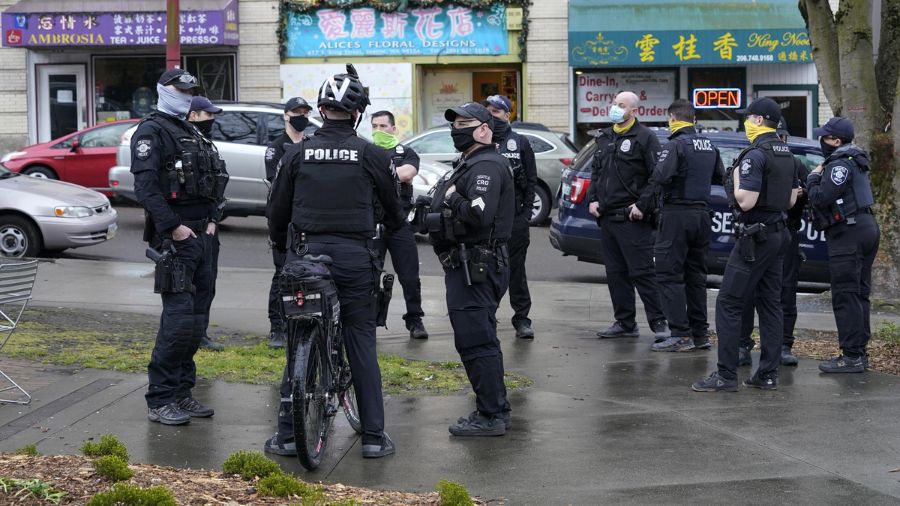Not the first time the Seattle waterfront was saved by a tunnel
Aug 8, 2018, 5:58 AM | Updated: Oct 4, 2022, 2:51 pm
In downtown Seattle at Fourth Avenue South and South Washington Street is the “South Portal” of a mile-long railroad tunnel beneath the city.
The tunnel runs from that spot near King Street Station, traveling below the streets of downtown Seattle to a similar “North Portal” along the waterfront north of Virginia Street, in the shadow of the Alaskan Way Viaduct.
Many people don’t even know it’s there, even though it’s been on the job since 1905.
And, says BNSF Railway spokesman Gus Melonas, it’s still serving freight customers and passengers, with 2,500 people and the equivalent of 12,000 truckloads of goods and other materials moving through the 113-year old subterranean corridor every day.
Digging of the tunnel was completed in 1904, and it was in 1905 that the first trains ran through it. But, says author and railroad historian Kurt Armbruster, you have to go back a few decades before that to understand why it was built in the first place, and how it almost didn’t come to be.
“In the 1880s and 1890s, [it was] railroad mania,” Armbruster said, standing on the sidewalk above the South Portal late last week, raising his voice above the din of buses and streetcars of morning rush hour.
Save The Showbox? Should have saved Arena, too
“Every square inch of Washington was being coveted by all these different railroad companies,” Armbruster said. “A lot of them were only [speculative] ‘paper railroads,’ they never got beyond that. But the ones that mattered did, and that’s how we come to enjoy this magnificent metropolis we have today.”
As Kurt Armbruster sees it, there’s a direct connection between the construction of the tunnel more than a hundred years ago and quality of life in Seattle circa 2018.
Early Seattle historian Clarence Bagley wrote in 1916 that the “passage beneath the city is Seattle’s salvation from a transportation standpoint . . . the city would have surely committed commercial suicide if the project of the Northern Pacific to erect a depot on the waterfront had been permitted.”
In the late 19th century, the “railroad mania” that Kurt Armbruster talks about meant big railroads battling with each other for dominance along particular routes and in particular communities.
For Seattle, this meant protracted debates and sometimes dubious deal-making regarding decisions about where tracks and other railroad facilities would be built. The two railroads that most often came to blows in the civic arena here were the Northern Pacific and the Great Northern.
The short version of this complicated soap opera is that the Northern Pacific wanted to build a major freight and passenger facility in downtown right along the waterfront. This would’ve required rejiggering of some streets and the closing of others, and the proposed development included a huge passenger station between Madison and Marion Streets, and an 850-foot long freight shed stretching from University Street to Madison Street.
Much like the Alaskan Way Viaduct is now maligned as a barrier between the city and Elliott Bay, the Northern Pacific plans were also criticized for similar reasons.
But this wasn’t so much about aesthetics; it was almost purely commercial. Add to this that the Northern Pacific was never the most popular railroad in Seattle; nobody had forgotten when they’d chosen Tacoma over Seattle for their West Coast terminus.
Fortunately, says Kurt Armbruster, Seattle had City Engineer Reginald H. Thomson who saw the problem – a narrow waterfront already congested with trains – and came up with a solution – a two-track tunnel beneath the burgeoning urban center, and the waterfront reserved only for transferring freight from ships to railcars. A depot – which ultimately was built as King Street Station – would be situated south of the South Portal and would serve both the Northern Pacific and the Great Northern.
Of the railroads that “mattered,” according to Kurt Armbruster, the one that mattered most to Seattle was the Great Northern.
Sound familiar? Original Seattle viaduct had no ramps
The Great Northern first reached the city in 1893, and owner James J. Hill — the legendary and larger-than-life business leader remembered as the “Empire Builder”—came to share Thomson’s enthusiasm for digging the tunnel and for placing the depot south of downtown.
Were it not for Hill’s support, it’s possible that the tunnel would have never been built. Hill assisted with the necessary political, economic and business maneuvers, and recruited Seattle’s famous Judge Thomas Burke to lead local efforts, including complex real estate dealings and other practical matters.
Apart from the political struggle, Kurt Armbruster says the tunnel was a fairly important milestone in the life of the young metropolis and the growing demands for complex infrastructure and other improvements.
“This was the city’s … first big urban planning problem: finding a place for all the railroad lines that were converging here in the 1890s,” Armbruster said.
Armbruster says that once tunnel construction got underway, the project proceeded smoothly and took just two years.
“They just used picks, shovels, and pneumatic drills,” Armbruster said. “They had an electric railroad which they used to [move dirt to] fill in the land along the railroad,” he said, filling and leveling what had previously been tidal lands from the South Portal down to where Safeco Field is now and along much of the waterfront from the North Portal.
But the construction project wasn’t completely trouble-free.
“There were two buildings, at least, that felt the effects of the tunnel building,” Armbruster said. “One was the York Hotel at First and Stewart, which had to be torn down because it was settling so badly. And the [then-]new Central Library which was under construction [also was damaged]. They had to actually jack it up and put concrete underneath to stabilize it.”
In more than a century of service, the tunnel has been quietly doing its job and is still in great shape. Gus Melonas of BNSF says it’s regularly inspected and is on a schedule of regular capital improvements. The tunnel was not damaged by the 2001 Nisqually Quake, Melonas says.
At age 92, Jack Christensen of Edmonds is just 21 years younger than the downtown railroad tunnel. Christensen worked for the Northern Pacific for many years and later for the Burlington Northern after a 1970 merger created the railroad that later, after yet another merger, became known as BNSF.
Was it exciting or maybe even thrilling to travel through the tunnel under downtown Seattle in the cab of a locomotive?
“It was pretty ho-hum, actually,” Christensen said earlier this week, recalling an estimated 1,000 trips beneath the city during his career.
“We’d go to work at [the big railyard at] Interbay and go down through the tunnel [in a locomotive] to get on our train at King Street,” Christensen said. “And of course, coming north, you’d leave your train at King Street, take your engines through the tunnel up to Interbay and put them away.”
As Kurt Armbruster surveys the South Portal and takes in the skyline just to the north – a 21st-century skyline built right over the top of the 1905 tunnel – does he believe that Seattle owes anything to James J. Hill?
“There was a synergy,” Armbruster said. “I think [Seattle] very much owes a lot to James J. Hill. He was a man of great vision, and he saw that this would be the metropolis of the Northwest if only it would listen to him and adopt a similar grand vision of how it could be in the world.”
On a scale of 1 to 10, with 1 being ignoring the “Empire Builder,” and 10 doing everything he said, how did Seattle do?
“Pretty much 10,” Armbruster said. “Oh yes, he was very persuasive. And the city adopted his and Reginald Thomson’s scheme pretty much thoroughly.”





















